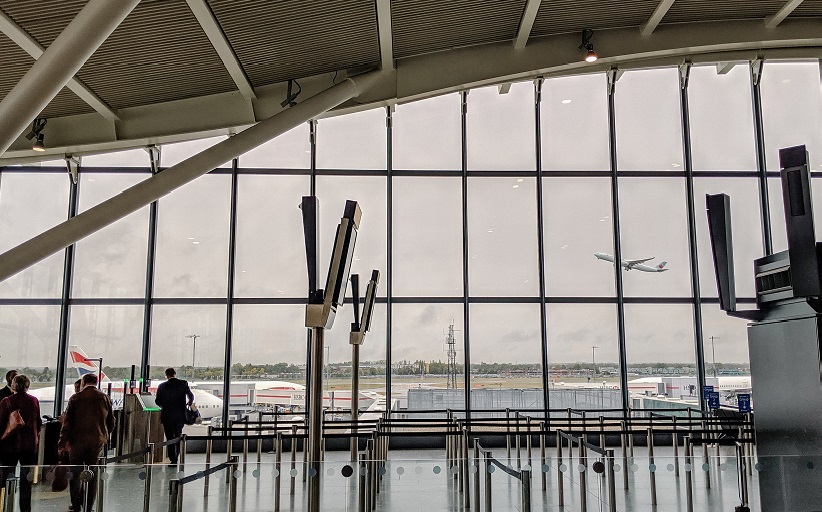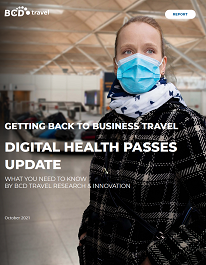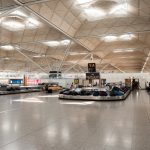Erol Arkan, BCD Travel Vice President, Global Solutions Engineering, took a trip from the U.K. to the U.S., which also included some U.S. domestic travel. Arkan and his family flew from London Heathrow to Philadelphia, from Philadelphia to Dallas-Fort Worth and on to Atlanta, before heading back to the U.K. from Philadelphia.
Here, he shares his experiences managing the complexities of pandemic travel and evolutions in the customer experience.
PRE-TRIP
How did you manage your destination’s entry and COVID-19 test requirements?
Erol: My first stop was BCD Travel’s COVID-19 Information Hub, where all the information I needed was easily accessible in a single location. It helped me prepare and action the extra rules in the COVID world beyond just booking trips and making sure my passport/Visa were valid. Since the Info Hub is in TripSource®, the options I booked were automatically sent for pre-trip approval. That same information was included in my proposed itinerary summary, so those approving my travel could view the requirements and risks associated with the destinations. The airline used my frequent flyer information to correlate and send me relevant trip instructions and a recommendation to use the VeriFLY digital health pass for travel.
The airline also suggested COVID-19 testing vendors, some with airline discount codes. I chose a mail-in test option to avoid the added chore of an in-office visit. The vendor electronically returned our results and required documents quickly.
AT THE AIRPORT
Erol: London’s Heathrow airport to U.S. gateways such as New York City, Boston, and Philadelphia have traditionally been some of the most important routes for transatlantic business travelers. While COVID policies continue to evolve, air travel volume between these cities has remained significantly lower than pre-COVID volumes. With vaccinations and more sophisticated policies for travelers emerging, this important route can be traveled efficiently and safely.
Tell us about airport check-in.
Erol: As you’d expect, there’s still a lot of signage reminding you to wear face masks. Hand sanitizer stations are everywhere in the terminal, and floors are marked to separate travelers standing in queues. The last was inconsistently observed, especially in the U.S. airports I visited.
When airline representatives requested my required forms, I was able to simply say, “I have VeriFLY.” From there, everything else in the check-in process was the same as before. It will be interesting to see how this experience changes by airline as standards start emerging.
What did you think about the digital health pass experience?
Erol: The process was easy and quick. I used the VeriFLY app, which is currently being used by Aer Lingus, Alaska Airlines, American Airlines, British Airways, Iberia, Japan Airlines and Royal Air Maroc. I uploaded/linked the QR code from the NHS (National Health Service) app to show my vaccine certificate and other attestations and required documents. I downloaded and stored PDF copies of my COVID-19 test result and U.K. arrival screening document in the TripSource® Document Vault. At check-in, agents simply looked for the big green VeriFLY check confirming I was “ready to travel.” Thanks to the app, I never had to show hard copies of my documents, but it was reassuring to have them safely stored elsewhere.
How did the security/immigration process differ?
Erol: There was really zero difference going through security in both the U.K. and U.S., other than more signs to promote social distancing, etc.
U.S. immigration was a bit strange. In Philadelphia, there were noticeably fewer people around to help, other than the border control officials in their booths. I wasn’t asked any questions related to COVID-19. It’s as if officials assumed that because I was cleared to fly, I must be COVID safe.
When traveling within the U.S. (Philadelphia, Atlanta and Dallas Fort Worth), you’d never realize we’re in a global pandemic. Airports were busy; all stores and restaurants were open (and crowded). Other than the signage, ubiquitous hand sanitizer dispensers, and 99% of people wearing masks all the time, it felt normal.
At U.K. immigration, U.S./EU/U.K. passport holders used the same queues (the self-service kiosks recognize the biometrics for all those passports). Other foreign passports queued separately. Officials confirmed travelers had their digital or printed pre-arrival COVID form. Travelers needing forms, those found to have discrepancies, or anyone rejected at the self-service booths joined different queues to speak with immigration officials.
ON BOARD
What was the onboard experience like?
Erol: Facemasks were required in the airport and during the flight. Passengers scanned their own boarding passes under gate agent supervision. That took a while because some travelers weren’t sure what to do. Repeated infight announcements reminded to wear masks at all times, except when actively eating or drinking. All food was served in covered/sealed packaging. In business class, courses were served all at once instead of separately.
THE TRAVEL EXPERIENCE
What were the travel pain points?
Erol: My No. 1 pain point absolutely was a fear that I’d test positive in the 72 hours leading up to my U.K. departure. If I had tested positive, I would have had to contact an agent to change my flight and hope I could buy/schedule another last-minute test. It’s stressful to know that a test which can only be done pre-trip could potentially disrupt the entire plan.
Since I’ve traveled, though, the U.K. has adapted easier travel rules, so that travelers from certain countries who have been fully vaccinated can skip pre-departure or day 8 COVID-19 tests; nor do they have to isolate on entry. They will still need to take a PCR test one day after arriving. My advice is to check the U.K. government site for the most current information.
What went better than you’d feared?
Erol: There were no real hassles. I suppose it’s because I took the time to read the smart messages provided to me at each phase of the trip via the TripSource app. I made sure I had the correct documents ready, and I was comfortable complying with rules for facemasks, social distancing, etc.
What did you get right?
Erol: Using the VeriFLY digital health pass worked well. Agents were able to instantly confirm that my family and I were fit to travel. Other travelers were slowed down by physical paperwork.
What did you get wrong?
Erol: Thankfully nothing went wrong, but the steps before check-in and upon arrival have become more complex. Extra care was needed to ensure we got all paperwork exactly right, and this caused some minor delays at U.S. immigration.
How were other travelers fairing? What seemed to be their most common problem?
Erol: Check-in and immigration processes are longer due to the extra checks now required. The most common problem seemed to be travelers failing to complete all required documents the day before departure and having the right documents uploaded digitally. Doing everything you can before arriving at the airport will certainly speed things up and relieve some of the pressure (on travelers and airport staff).



